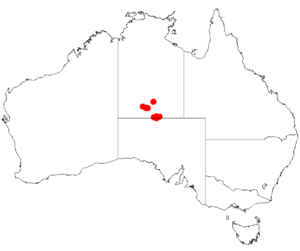Latz's wattle facts for kids
Quick facts for kids Latz's wattle |
|
|---|---|
| Conservation status | |
|
VU (TPWCA)
|
|
| Scientific classification | |
| Genus: |
Acacia
|
| Species: |
latzii
|
 |
|
| Where Latz's Wattle grows in Australia (data from AVH) | |
Acacia latzii, also known as Latz's wattle or Tjilpi wattle, is a type of shrub or small tree. It belongs to the Acacia genus, which is a large group of plants often called wattles. This plant grows naturally in the southern part of the Northern Territory and the northern part of South Australia in Australia.
Contents
What Latz's Wattle Looks Like
Latz's wattle can grow to be a shrub or a small tree, reaching a height of about 3 to 7 meters (around 10 to 23 feet). Its small branches can be smooth or have tiny, flat hairs.
Its leaves, called phyllodes, are long and narrow, usually 5 to 10 centimeters (2 to 4 inches) long and 2 to 4 millimeters wide. They are tough and have a khaki or grayish-green color. Like the branches, they might be smooth or have fine hairs. These leaves have many veins running very close together.
The flowers grow in small groups of two to five, forming a cluster. Each flower cluster is round, about 4 millimeters (0.16 inches) wide, and contains 13 to 18 tiny flowers. These flowers have five parts, and their sepals (the leaf-like parts that protect the bud) are separate.
After flowering, the plant produces smooth, tough seed pods that can be up to 15 centimeters (6 inches) long. Inside these pods are dull, brown-black, oblong seeds, each about 5.5 millimeters (0.2 inches) long. Latz's wattle usually flowers from April to August and produces fruit from February to November.
Where Latz's Wattle Lives
This plant prefers to grow in rocky, alkaline soil. You can often find it in gullies (small valleys) and on the lower slopes of hills.
Why Latz's Wattle Needs Protection
Latz's wattle is considered "vulnerable" by both Australian and Northern Territory laws. This means it's at risk of disappearing if we don't protect it. Here are the main reasons it's in danger:
- Increased Fires: A type of grass called Buffel Grass has spread into its habitat. This grass can cause more frequent and intense fires, which harm the wattle.
- Animal Damage: Young wattle plants are often eaten or trampled by cattle and other wild animals like goats or camels. This makes it hard for new plants to grow.
- Small and Scattered Groups: There aren't many Latz's wattle plants left, and they are spread out in small, separate groups. This makes them more vulnerable to problems.
- Changing Weather: Changes in rainfall patterns, possibly due to climate change, might affect how well adult plants survive and could reduce the chances for new plants to grow.
How Latz's Wattle Got Its Name
The plant was first officially described in 1980 by a scientist named Bruce Maslin. He named it A. latzii to honor Peter Latz. Peter Latz made "fine" collections of this plant, which helped Maslin describe it properly. One important sample, collected by Latz in 1977, is kept in a special collection called CANB 267113.1.


